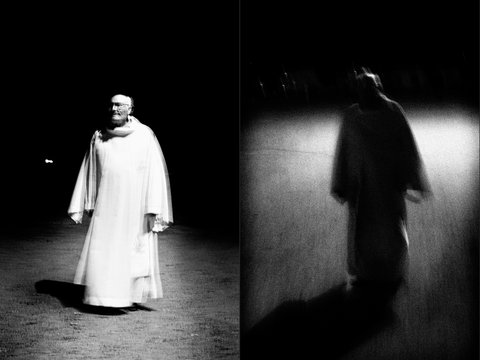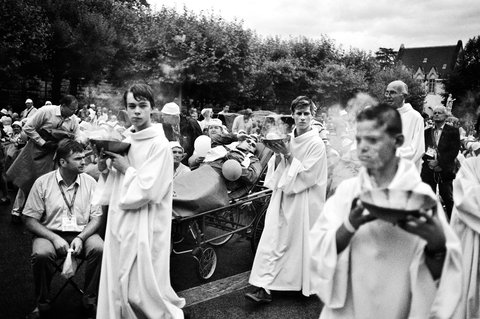A Photographic Vision in Lourdes
It’s easy enough to caricature the spectacle of the pilgrims who flock to Lourdes. On crutches, wheelchairs and gurneys, the broken in body — but not in spirit — pray and meditate in the very grotto where a 14-year-old Bernadette Soubirous said she saw the Virgin Mary in 1858.
To secular sorts, it’s a hard thing to grasp. For Jeppe Bøje Nielsen, a Danish photographer, it was a challenge. He spent a month last summer amid the throngs who packed the Masses and processions at the French town, intent on avoiding the straightforward documentary approach that other photographers had relied on.
“Everything was focused on the curiosity of the place,” said Mr. Nielsen, 38. “It was hard to juggle the feelings of fascination and, to a certain extent, of the grotesque, though that’s not the right word because it’s too negative. But it’s so unreal. It doesn’t happen anywhere else, to see the sick processed and revered. To an outsider, it can be odd.”
So it was for him, too. He had been there as a teenager, once, but his memory was dim — “the water in the fountain was warm” was about all he recalled. This time, he set out to find something more elusive, something beyond the prayers and processions, or the clash between the sacred rituals and the commercial come-ons.
“Lourdes is so thoroughly photographed that the photographic aesthetics are almost stored in the viewer in advance,” he said. “You cannot photograph miracles or faith in Lourdes. One can only photograph the symbols — or the clichés.”
Yet he was let down when he went over his initial images. He wanted to capture what he felt, not just what he saw.
“There was no emotion in the pictures I had done in the first few days,” he said. “I wanted to do photographs that were a little more open to interpretation. They had to be scrambled and experimental.”
He decided that his images — which were done for his degree at the Danish School of Media and Journalism — would be shot at night. Working just a few hours, he captured grainy, fleeting scenes of figures moving through the crowds, or contemplative moments. In a few, the scale of the place is overwhelming. In others, the mystery seems just as unsettling.
He thought he would have been put off by the sheer theatricality. Instead, as he spent hours with pilgrims, he was humbled. He met many people who told him they came to pray for others, not themselves. He found mothers of seriously ill children who said this town in the south of France was the only place where their child felt accepted.
“I met the mother of a 17-year-old by who had autism,” Mr. Nielsen recalled. “She told me, ‘Here, he is part of the normal group. Once he goes home, he’s the odd one again.’”
Bernadette herself faced no small measure of scorn and suspicion in her time, though her story was eventually accepted by the church hierarchy. Mr. Nielsen — who described himself as a doubter by nature, even though he is the son of a Lutheran pastor — mulled over the girl’s story, too.
“Bernadette saw the Lady in White in 1858,” he concluded. “I say ‘saw’ not ‘allegedly saw.’ I read her story and talked to a lot of people and found her story to be credible. She had no incentive to lie. Everybody was wary of her. But the odd thing is it’s hard not to believe her story.”
The Rev. James Martin, a Jesuit priest and author of the book “Lourdes Diary,” agreed.
“She refused gifts, even though her family was poor,” he said. “It cost her a great deal to talk about it. At one point she was kicked out of her local rectory by an imperious parish priest. And there are great parallels between Bernadette of Lourdes and Mary of Nazareth. In both cases, something supernatural happened to a poor young girl in a backwater town.”
At its core, he said, Lourdes celebrates the miraculous.
“That,” Father Martin said drily, “poses something of a challenge to the post-enlightenment mind.”
Mr. Nielsen’s photographs, he said, captured the shrine’s devotional mood, especially in the faces, which he found quite moving.
When he speaks of his time in Lourdes, Mr. Nielsen often invokes the word “humble” — whether he was talking about the sick who prayed for others, or the Gypsy caravans who descend upon the town each year to sell their goods and to worship. When he asked one of the group’s older members about his motivation, the man was blunt.
“He said, ‘I don’t ask anything of God. He tells me what to do,’” he recalled. “I asked him about doubts, but he didn’t have any.”
One man he encountered had doubts aplenty. Near the end of his time in Lourdes, Mr. Nielsen met Éric Saint-Germier, a man whose cancer was surpassed only by his anger and bitterness.
“He was scared of dying, since the only thing keeping him alive was his medication,” Mr. Nielsen said. “He spoke of fear and regrets. I spent two days with him. I sensed he had not spoken to anybody honestly for a very long time.”
Mr. Saint-Germier rebuffed Mr. Nielsen when he first asked to take his portrait. But he relented. Mr. Nielsen took a few minutes to do the shot, and went back to drinking beer and talking.
“He said he was only sharing this with me because I was a stranger,” Mr. Nielsen said. “There is something very special in talking to someone who knows they are going to die before Christmas.”
Mr. Saint-Germier died last month. Mr. Nielsen intends to return to Lourdes to spend more time seeking out others like him.
“Everybody everywhere has a story,” he said. “But those who go to Lourdes have a harder story.”
Avviso: Le pubblicità che appaiono in pagina sono gestite automaticamente da Google e sono necessarie a poter mantenere gratuite queste pagine. Pur avendo messo tutti i filtri necessari, potrebbe capitare di trovare qualche banner che desta perplessità. Nel caso, anche se non dipende dalla nostra volontà, ce ne scusiamo con i lettori.








